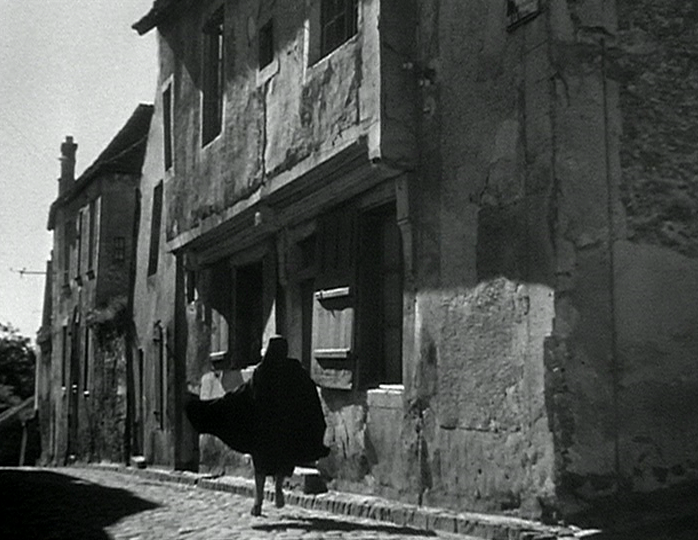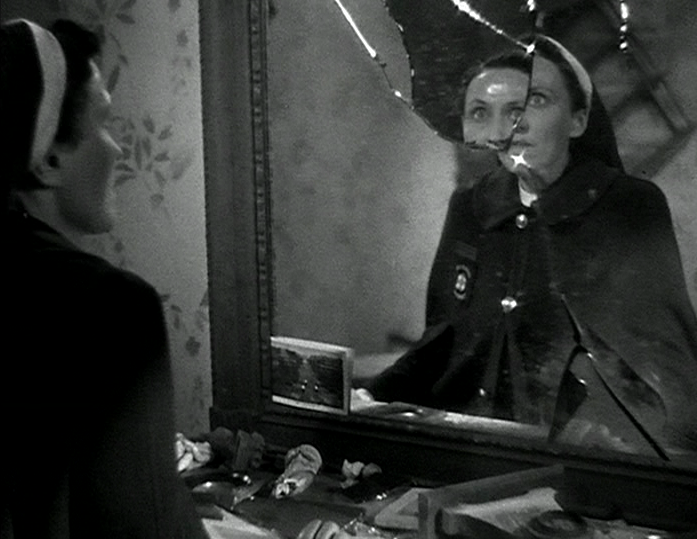

“You think people are all good or bad. You think good is light and evil is dark. But where does each begin? Where’s the frontier? Do you know which side you’re on?”
Le Corbeau seems innocuous in the twenty-first century, but it is one of the most controversial films in French history due to its content and its era. The film’s negative depiction of the French citizenry resulted in a lifetime ban from working in France for director Henri-Georges Clouzot (which was shortened to a blacklisting of only several years after protests), and landed the film’s principal actors in prison for a brief time.
The film was made during Germany’s occupation of France in the 1940s and although it was popular with audiences, it was politically unpopular—it angered the right-wing Vichy government, the left-wing Resistance, and the Roman Catholic Church—and was eventually banned. The film presented a misanthropic view of humanity, featuring malicious characters with a disregard for fidelity in marriage and moral values, willing to deceive and betray one another. It also negatively depicted anonymously informing on your neighbors, a practice that was common in Vichy France as thousands of letters were sent to authorities denouncing neighbors, relatives and acquaintances. After France was liberated, there was still political contention because the prevailing notion at that time was that France was a nation of resistance fighters while the film’s characters are mostly depraved.
Le Corbeau tells the story of a small town plagued by a series of anonymous “poison pen” letters that accuse various town members of misdeeds, and are signed with a drawing of a crow (le corbeau is French for “the crow”). The mysterious author of the letters knows the secrets of everyone in town—who is sleeping with whom, who has a drinking problem, who is dishonest in their business dealings. The first letter accuses Dr. Germain (Pierre Fresnay) of having an affair with Laura Vorzet (Micheline Francey), the young wife of his elderly colleague, Dr. Vorzet (Pierre Larquey), and of committing illegal abortions. Germain, already emotionally damaged by his past, is disgusted by the perversion of human nature, and sets about trying to clear his name and discover the source of the rumors.

Subsequent letters reveal many secrets about the residents, undercutting their upstanding reputations, revealing them to be scheming and duplicitous. Some who receive letters choose to confide their contents to others, and the town’s vices are soon brought to the surface of the previously placid environment. Even the most respectable members of the town are accused of gruesome misdeeds. On one hand, the letters are somewhat benign; they are rumors, and can be treated as such. But they also engender anxiety and distrust for the town’s leadership amongst the people, The situation takes a solemn turn when a hospital patient commits suicide after receiving a letter telling him that his cancer is terminal.
The leaders of the town are somewhat reluctant to pursue the author of the letters, perhaps a veiled reference to the French government allowing the Germans to dictate life in France. However, it is not just the prominent figures in the town that are guilty. Ordinary citizens begin reading letters not addressed to them, scam each other for financial gain, and refuse to pay for services based on unfounded rumors. Suspicions settle on Marie (Héléna Manson), Laura’s sister, an ill-tempered nurse whom we are led to believe is jealous of her sister. She briefly flees from authorities, but is eventually arrested. During her flight, her black robe flutters in the wind, mimicking the wings of a crow.
The film’s deliberation on good versus evil is succinctly captured in a visual display of light and darkness. Vorzet and Germain have a discussion in a darkened room, a single lightbulb swinging between them. Germain says that he is absolutely certain in determining right from wrong; Vorzet counters by saying that the dividing line between good and evil is as elusive as the shifting light. When Germain burns his fingers trying to steady the bulb, Vorzet concludes that his point is valid: true morality is not to be grasped.

While Marie is in captivity, another letter is dropped from the balcony during a church service. This time, all people seated in the area from which the letter fell are brought in for a dictation—they must sit and write the words that are spoken to them, so that their handwriting can be compared to the corbeau letters.
This time suspicions fall on Denise (Ginette Leclerc), a crippled temptress that has constantly feigned illness so that Dr. Germain would make house calls. She faints during the dictation, though the results are deemed inconclusive. Shortly after, Germain discovers Denise writing a corbeau letter to him, telling him that she is carrying his baby. They have an earnest discussion in which she convinces him that she is not le corbeau, and had only written the one letter, and they decide to keep the baby.
In a summary, it is difficult to elucidate the intricacies of the plot and the performances. While the film is cynical, it is not drab. Germain’s efforts to uncover the mysterious writer of the letters and Denise’s nonchalant disregard for social conventions give the film a certain vitality. Its resolution is unclear. There is a bit of hope: The guilty party receives punishment, and the main characters end the film looking forward together to the birth of their child, with a new perspective and appreciation for life. But the director’s bleak view of humanity remains as well. An innocent person is sent to an asylum, and a murderer is allowed to roam free, one crime being put to rest by another.

The broader point that the film seems to be making is that any of the residents of the town could have been le corbeau. Once the letters started, everyone succumbed to the worst aspects of themselves, displaying latent capacities for evil. While the film certainly presents a negative view of many issues of its time, it transcends its era to sketch a bleak picture of the pervasive corruption of mankind.
Viewing the film in the twenty-first century America, it doesn’t seem as depraved as it would have appeared in 1940s France, which reinforces the notion of the general depravity of modern society. The plot of the film is still compelling, and the acting is solid throughout. Through clever storytelling, we don’t suspect the true culprit until they are revealed as such on screen. Although the history surrounding the film does add a certain weight, removed from that context it still stands as a fine film.